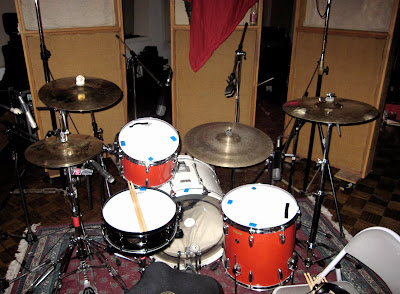


The jaunty lads of Far From Finished came down to The Outpost in Stoughton, MA to begin work on their new CD for Old Shoe Records. Drummer Mark Cannata tracked 13 new songs including a couple kit changes to mix things up. We recorded the bulk of the songs in the center of the studio's excellent main tracking room using my 13 x 9" and 15 x15" Eames toms and the house 22 x16" Yamaha Stage Custom bass drum, then moved the kit to the corner of the room, surrounded it with baffles, and I then heavily dampened the kit with Moongels and paper towels. The different drum sounds will be used to highlight and contrast dynamic changes between the verses and choruses in a couple songs. Mark's heavily corroded solid maple 14 x 5.5" DW Craviotto (pictured above) was a wreck when he brought it in, but after adding batter and snare side heads, new Puresound snarewires, and lubing the tension rods, it sounded great and made it onto 3 tracks. My 14 x 5.5" brass Sensitone was used on 5 songs, and the always-useful Pearl Steve Ferrone made it onto 4 tunes. For an as-yet-untitled song, Mark wanted a drum kit that had a loose, old timey carnival vibe, so I detuned and loosened the snares on a 13 x 6.5" Yamaha Sensitive Series drum , used an old 16x16 Stage Custom floor tom tuned wide open as a kick drum, threw up a circa 1930s 11" Avedis Zildjian sock cymbal and a cowbell. and we got a great raunchy sound thanks to producer/engineer Jim Siegel .
I also had time on this project to tune the snare drums to specific notes that would work with the key each song was in. If the desired snare drum can't hit the actual key of the song and maintain the character we need, I try to tune it to a third or fifth of the note. I've been trying to do this a lot lately when possible, and although most people wouldn't notice it, an in-tune snare drum adds to the overall musicality of a song and has a mild positive psychoacoustic effect on the listener. (I just made that theory up but I think there's an element of truth in there somewhere)

What did you use to lube the rods/lugs?
ReplyDeleteOn a different note (no pun intended) how does one clean the bearing edge of a brass shell? It's a little sticky and looks as if it's pitting on the edge.
Always learning things on this blog.
Thanks.t
I've read that to tune a drum to a specific note, you tune both heads to that note. I've also read that both heads should be tuned a minor third below the note you're shooting for, which doesn't make sense to me. Does any of that sound stoopid?
ReplyDeleteAnd do I have any hope of ever being able to distinguish which of the thousand overtones I should be listening to when I tap at each lug?! The more I do it the harder it gets.
Ben,
ReplyDeleteI use an extreme pressure red grease like TriFlow or Mobil 28 for lubricating tension rods. As far as cleaning the bearing edge of a brass snare drum, I use a mild soap and warm water combo when I clean a metal shell. If you used something stronger like Windex or Dirtex just on the edge of the shell it would probably be okay, but I wouldn't make a habit of it. Good luck!
Jon
Alex,
ReplyDeleteThat's a huge and complicated topic that I will probably cover in a future posting. I've got my own system that doesn't in any way resemble the one you listed, but that doesn't make it wrong or better, it's just what works for me.
I've found it to be really crucial that I have a good listening environment when I tune to a specific note and that I hit the drum with the snares on and off near the center of the drum at the same velocity the drummer will be hitting.
All that being said, I never tune the top and snare side head to the same note - it just never worked out well for me. Also, if I can, I'll use a Peterson Strobe Tuner which gives a good visual representation of the note. Experiment and report back to me.
Jon